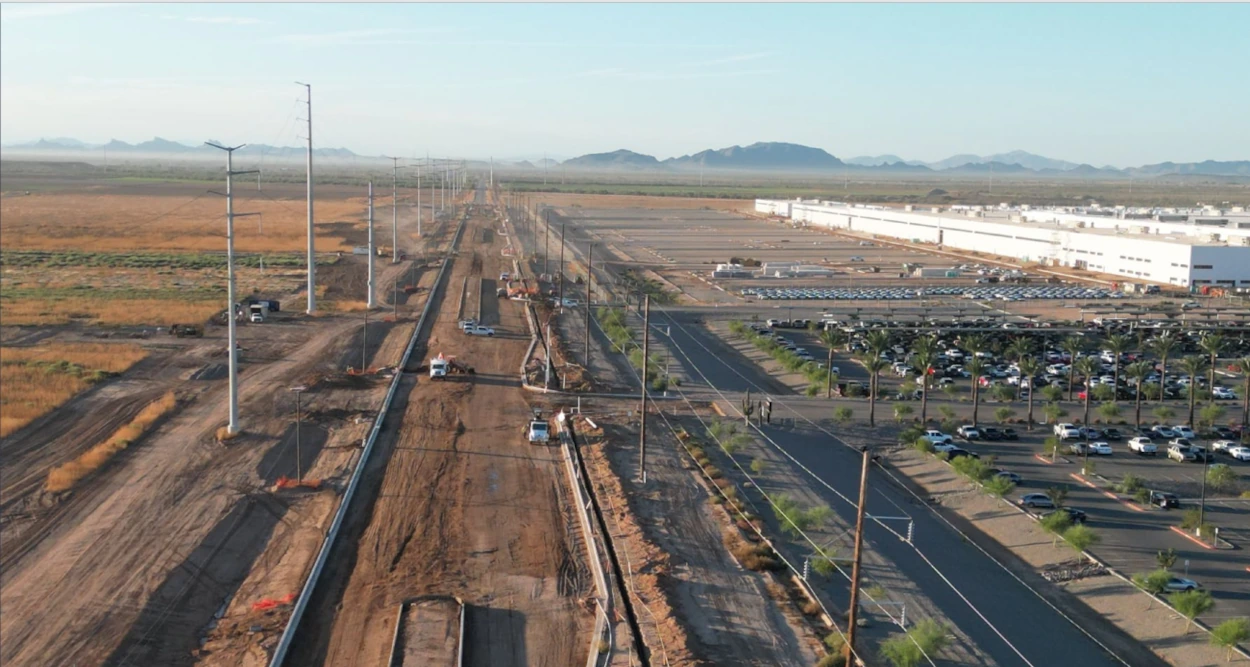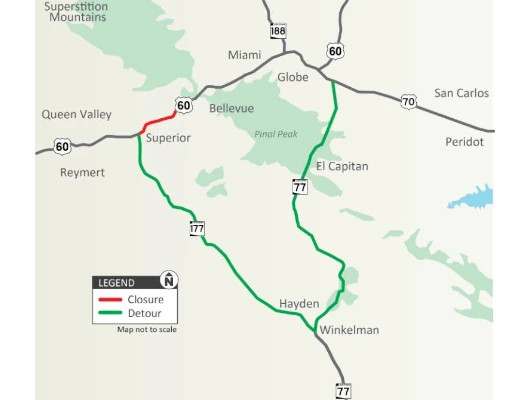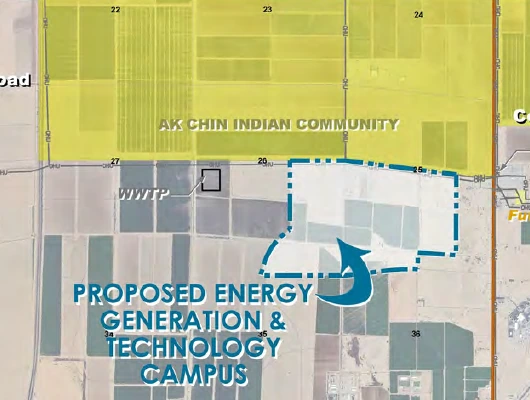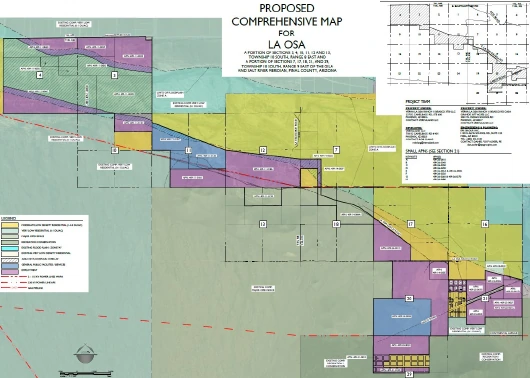City Staff Proposes New Ordinance to Address Infrastructure Protection and Cost Recovery
The Casa Grande City Council heard a comprehensive presentation Monday evening, August 4th, on proposed changes to how the city manages its public right-of-way, with staff recommending new fees, stricter oversight, and enhanced coordination with utility companies.
Civil Engineer David “Mac” Harmon presented the proposed Right-of-Way Occupancy Ordinance during a work session, outlining plans to better protect city infrastructure while ensuring fair cost recovery from entities working in public spaces.
Current Challenges Drive Need for Change
Casa Grande currently handles right-of-way permits through its Public Works Department within the Engineering division without a formal right-of-way team, with some permitting intake also handled through the development center. The existing process begins when utility companies or developers plan improvements, submit applications for city review, receive permits with specific conditions, then contractors perform the work under city oversight, undergo final inspection to ensure the right-of-way is returned to acceptable condition, followed by a one-year follow-up inspection to verify restoration quality before administrative closure.
However, Harmon highlighted several mounting problems. The city is set to probably issue the most right-of-way permits in at least the last 10 years based on data he gathered, leading to increased frequency of issues including improperly installed trench plates creating safety hazards, restoration work not being completed after utility installations, and construction occurring without proper permits.
“We’re seeing more and more right-of-way use. And so as that increases, we’re seeing just more frequencies of the problems,” Harmon explained, noting that unauthorized work forces the city to fix problems at taxpayer expense when responsible parties cannot be identified.
Regional Comparison Shows Room for Improvement
Staff research revealed that most similar-sized Arizona cities maintain dedicated right-of-way management teams. Examples include Marana, Sierra Vista, and Apache Junction, which have dedicated right-of-way teams, while Casa Grande has no formal ROW team. The comparison also included Florence, which has ROW oversight embedded in its Engineering Division, Maricopa, which likely has embedded oversight that is not standalone, and Goodyear, which has ROW oversight embedded in Engineering/Public Works.
City Manager Larry Rains emphasized the preliminary nature of the presentation: “We are just at the front end. We have a lot of ideas. This is a 30,000 elevation foot view.”
Proposed Ordinance Changes
The draft ordinance includes several key provisions that may require city code amendments:
- Right-of-way occupancy permits required for all work within the right-of-way
- Open occupancy permits for franchised utility companies
- Minor occupancy permits for small, temporary uses like news racks and sales
- Special event and block party right-of-way occupancy permits
- Holiday blackout schedule
New application requirements would require traffic control plans for any devices placed in public rights-of-way and establish standardized notification processes for city departments, affected businesses, and residents. The proposal also includes potential integration with the Arizona 511 system for closure notifications, which could potentially communicate with Google Maps, Waze, and other navigation systems.
Addressing the Pavement Cut Problem
One major focus involves protecting newly constructed roads from premature deterioration caused by utility cuts. Harmon explained that pavement cuts create a negative cycle where imperfections lead to cracks, potholes, and eventual costly repairs that push problems down the road rather than solving them.
Harmon described the city’s use of the Pavement Condition Index (PCI), a measurement system that rates road health on a scale from zero to 100 based on physical and visual characteristics of the road surface. A brand-new road starts with a perfect score of 100, but as it degrades, the cost to rehabilitate that road grows exponentially.
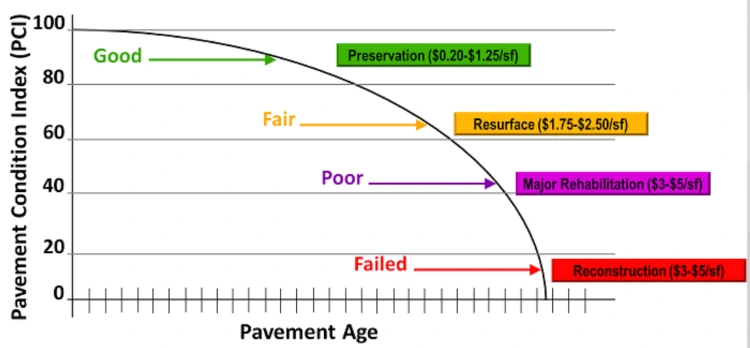
When pavement cuts occur, they create imperfections that lower the PCI score. These imperfections eventually grow into cracks and potholes, requiring corrective action that involves cutting out larger sections and replacing them. However, this creates a negative feedback loop where the replacement section still represents a pavement cut, perpetuating the cycle and extending maintenance costs.
“We really want to prevent and avoid cuts on our new roads as much as possible, because that extends the life cycle as well as the maintenance cost to keep that road up and running and at a high PCI,” Harmon explained.
The proposed solution introduces pavement cut fees depending on both road age and classification.
Pavement Cut Fees
| Age of Pavement (months) | Group 1 | Group 2 | Group 3 |
|---|---|---|---|
| 0–12 | $3,950 | $8,250 | $12,500 |
| 12–24 | $3,350 | $7,150 | $10,800 |
| 24–48 | $2,450 | $5,350 | $8,200 |
| 48–84 | $1,650 | $3,350 | $5,500 |
The groups are defined by street type, with Group 1 including local streets and minor collectors, Group 2 covering major collectors and minor arterials, and Group 3 encompassing minor arterials and principal arterials. These fees, developed with consultants Rider Levett Bucknall and Ninyo & Moore, account for factors including asphalt maintenance, traffic control, quality assurance, city inspections, and the probability of future trench failures.
“The benefit of adopting a fee for those pavement cuts is now you’re encouraging trenchless technologies,” Harmon said, explaining that when traditional cutting costs match trenchless alternatives, companies choose methods that avoid road damage entirely.
Encouraging Faster Right-of-Way Clearance
The proposed ordinance includes right-of-way use fees that aim to incentivize contractors to minimize their impact and complete work quickly.
| Use Duration (weeks) | Cost per sq. ft. of ROW usage |
|---|---|
| 0–1 | $0.00 |
| 1–3 | $0.25 |
| 3–6 | $0.50 |
| 6–9 | $0.75 |
| >9 | $1.00 |
| Fees include all ROW impacts (landscaping, sidewalks, etc.). |
“We want people constructing in the right-of-way out of the right-of-way as soon as possible,” Harmon explained, noting that faster completion reduces risks and costs for businesses, the city, and road users.
Phoenix Barricade Manual Adoption
Staff recommends adopting the City of Phoenix Barricade Manual as a regional standard already familiar to many contractors. The manual provides clear requirements for lane closures, pedestrian access, and ADA compliance, though staff acknowledged it may require Casa Grande-specific modifications.
Engineering Standards Updates
The presentation included updates to engineering design standards, notably increasing the width on minor arterial sections from 110 feet to 120 feet to accommodate right-turn lanes and improved traffic flow.
Council Concerns About Implementation
Mayor Pro-Tem Matt Herman expressed concerns about creating burdensome permitting processes for downtown events and community activities like the Main Street Fair and Rotary Oktoberfest. Harmon responded that the current system confuses event organizers by forcing them to use permits designed for utility construction work. The proposed changes would create more appropriate permits for different types of activities, making the process easier rather than more difficult.
Stakeholder Feedback and Expected Resistance
Staff sent drafts to Arizona Water Company, Southwest Gas, and engineering firm Allison Mills to seek feedback, receiving responses from Southwest Gas and Arizona Water Company. However, Harmon acknowledged anticipated resistance to the pavement cut fees.
“I think there’s definitely gonna be a challenge with that. It’s going to add cost to their projects, just plain and simple,” Harmon said. “The other side to that, though, is that I think the city can play a role where we’re informing them about that and trying to give them our CIP plan in advance and try to work with them.”
Implementation Timeline
Harmon expressed hope to have something ready before the end of the year so that open occupancy permits could begin on a calendar-year cycle in January, though he acknowledged uncertainty about whether this timeline was realistic. The ordinance requires coordination with the city attorney’s office, finance department, and other departments to address bonding requirements and code amendments.
Staff plans to continue gathering feedback from stakeholders before returning to council with a more detailed ordinance draft. The proposal must undergo additional vetting and potentially amendments based on stakeholder input before final consideration.
The work session represents the beginning of a comprehensive effort to overhaul Casa Grande’s right-of-way management, with final adoption dependent on successful navigation of legal, financial, and stakeholder concerns while maintaining the city’s commitment to balanced infrastructure management.
